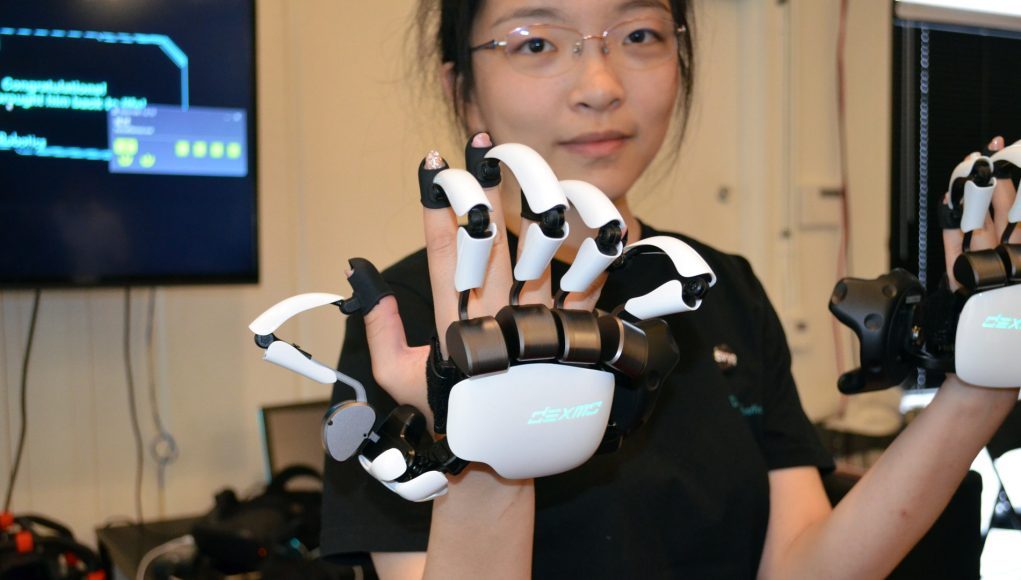With a development journey starting way back in 2014, Dexta’s Dexmo haptic force-feedback VR gloves have come a very long way. I recently went hands-on with the latest version of the company’s gloves, which are now production ready, and came away impressed with their compact size and freedom of mobility.
Dexta Robotics originally envisioned building a consumer force-feedback glove for VR but has in recent years pivoted the Dexmo gloves toward the enterprise market. While CEO Aler Gu says the company is still very intent on delivering a more refined and affordable consumer product in the future, for now it’s opened sales for enterprise customers. Dexta is selling the gloves on a case-by-case basis and hasn’t publicly disclosed the price.
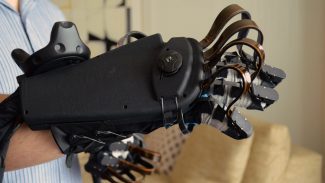
The latest version of the gloves are production ready and surprisingly sleek and sharply designed compared to other force-feedback gloves I’ve tried. Dexta’s nearest competitor is very likely HaptX, which offers some really compelling haptic and force-feedback, though its latest prototypes are bulky and require a huge tether connected to each glove which largely limits HaptX to ‘stand in place’ use-cases.
The Dexmo gloves, on the other hand, are compact and battery powered, thereby supporting the same kind of room-scale VR experiences that most of today’s headsets are capable of.
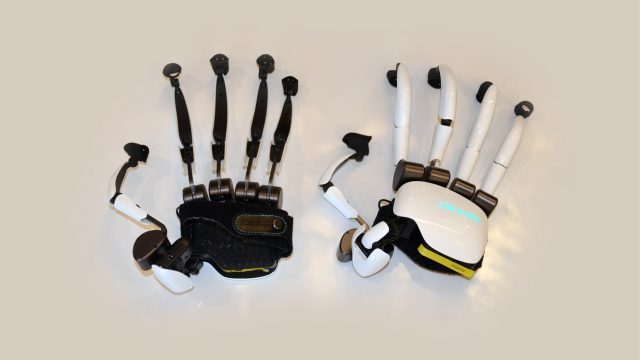
Quick primer on ‘haptic’ and ‘force-feedback’ for this article: ‘haptics’ here means some sensation that replicates a feeling of touching something, while ‘force-feedback’ means the ability to actually push back against your fingers to make it feel like you’re grabbing virtual objects that aren’t actually there.
Dexmo offers both. Haptics come in the form of vibrators (LRAs); there’s one in each finger and two in the palm section in the glove. Force-feedback comes from the glove’s ‘fingers’ which are connected to each of your own. Motors in each of the glove’s fingers can stop your fingers in place to give a sensation of grabbing objects of varying shapes.
Additionally, Dexmo’s force-feedback is ‘active’ which means the motors not only can stop your fingers in place, they can also push and pull against them, as well as offer variable force control to emulate squishy objects or add additional haptic sensations (like a button which has some initial resistance and then ‘clicks’ after enough force is applied).
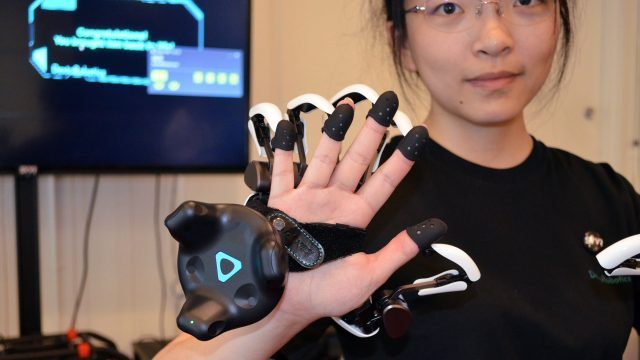
Fitting the glove involves strapping a section of the glove around you palm and then sliding your fingertips into little sleeves. The right fit for the sleeves is important; you want them tight enough to stay in place and to transmit the vibrations from the haptics while not being too tight that they squeeze the blood out of your fingertips.
Comfort is a huge challenge for any kind of force-feedback gloves because your hands and fingers need to be secure enough that the glove can impart force against them, but if you go too tight on any of the adjustments then your hands will become uncomfortable quickly. Luckily Dexta provides various sizes of the fingertip sleeves and makes them easy to swap in and out, so I was able to find a size that hit that Goldilocks zone.
Once the gloves are on you can feel some added physical resistance from the motors. That is to say that even when they aren’t actively providing feedback, there’s enough friction in the system that you can feel some drag on the movements of your fingers, though not enough to impact normal hand use. The company told me that this could be fixed in the future but would require a more specialized motor design, something that would be more feasible to explore once they are doing larger scale production.
In addition to haptics and force-feedback, the Dexmo gloves also track your finger positions by reading sensors in the gloves. After a calibration step which had me hold my fingers in a few different poses, I could see my fingers in VR articulating mostly realistically, save for the thumb on both hands that didn’t seem to want to cooperate (when I did a ‘thumbs up’ it wouldn’t extend upward). Dexta indicated this was a bug of some sort. Otherwise my other fingers seemed to track fine; the glove uses the finger tracking information against an API to determine when and how it should engage force-feedback.
Considering how (relatively) small the gloves are, and how much leverage there is from each motor (at the knuckle) all the way to each finger, I was surprised to find that the gloves offered ample stopping power for my fingers. When I reached out to pick up virtual objects I got a convincing ‘grip’ sensation that relayed to my brain that I was holding something. Because each of the fingertips of the glove can pivot at their attachment point, there’s definitely a ‘best’ way to grab objects for the most realistic sensation (fingers curved in just a bit). Once I got the feel for this, I really enjoyed the grabbing sensation the gloves offered, and it definitely made interactions of grabbing and holding things feel more real, especially because I could tell I was still holding something even when it was outside of my field of view (without force-feedback you have only your eyes to tell you whether or not you’re holding a virtual object).
Dexta also showed me how the ‘active’ nature of the force-feedback could be used by giving me a squishy object to play with—which pushed back against my fingers light at first and then harder as I squeezed more, until they stopped altogether—and also put a virtual beating heart in my hand which pushed my fingers back a bit with each pulse.
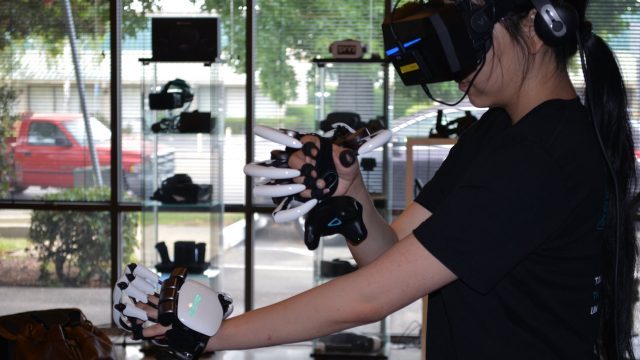
The haptics in the glove certainly seem like they have potential, but Dexta admits they are still at the very beginning of figuring out how to best use them. LRAs are capable of lots of interesting sensations which can convey things like clicks, rumble, and even complex surface texture, but doing so requires a lot of expertise in figuring out how to dynamically drive the frequencies to create these sensations. Indeed, in the demos I tried, the haptics felt coarsely implemented. The company plans to spend more time honing their library of haptic effects.
Between the Dexmo gloves and others that I’ve tried, I was really surprised how minimally they limited my natural finger dexterity. Outwardly, the design of the glove looks somewhat intrusive as it gives your hand an exoskeletal profile, but the way that all of the mechanical elements stay on the back of the hand means that the freedom of movement of my fingers was nearly untouched. Even the fingercaps are pretty unobtrusive; I was surprised to find that I could easily open a water bottle with a slim-profile cap while wearing the gloves with no problem. I was also able to put on and easily adjust my own headset, something which I needed help doing when I tried the bulky HaptX gloves.
I’m most impressed with Dexmo’s mechanical functionality and hardware design, but where the company now really needs to focus its efforts is on the software side. Any kind of gloves like these need a mature SDK that developers can use to make the gloves work with their applications; this is an area where HaptX is far ahead.
Running the simulations and determining the logic which drives the mechanics of the gloves for consistent and realistic feedback is no small feat. While Dexmo’s force-feedback worked well for what I would call ‘whole hand’ actions, more nuanced interactions with individual fingers seemed to confuse the system at times. As did passing objects between hands, which was an awkward affair that required very deliberate motions to get the system to understand what I was trying to do. In the demo I tried, the gloves also had very little idea what to do when I reached out to touch immovable objects like walls (the fingers would move spontaneously and unrealistically).
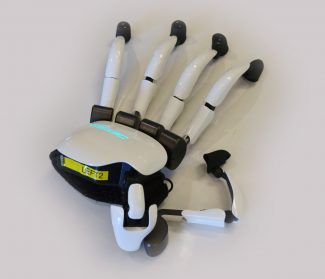
Force-feedback (and haptics) is all about conveying useful information to the user through the sense of touch. If the feedback being offered isn’t consistent and clear, it reduces the reliability and therefore usefulness of the information.
Making Dexmo’s force-feedback more consistent by better tuning the software is something the company needs to work on (and I relayed as much), but I left my demo otherwise very impressed with the hardware foundation that the company has built. There’s a lot of potential in the capabilities of the Dexmo glove that I would love to see shine once the software driving it is better tuned. Considering the company’s persistence in getting their hardware to this point over the last five years, I have reason to believe they’ll be up to the software challenge too.

